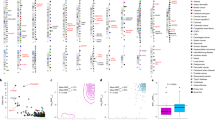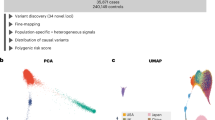Abstract
The Ashkenazi Jewish population has a several-fold higher prevalence of Crohn’s disease (CD) compared with non-Jewish European ancestry populations and has a unique genetic history. Haplotype association is critical to CD etiology in this population, most notably at NOD2, in which three causal, uncommon and conditionally independent NOD2 variants reside on a shared background haplotype. We present an analysis of extended haplotypes that showed significantly greater association to CD in the Ashkenazi Jewish population compared with a non-Jewish population (145 haplotypes and no haplotypes with P-value <10−3, respectively). Two haplotype regions, one each on chromosomes 16 and 21, conferred increased disease risk within established CD loci. We performed exome sequencing of 55 Ashkenazi Jewish individuals and follow-up genotyping focused on variants in these two regions. We observed Ashkenazi Jewish-specific nominal association at R755C in TRPM2 on chromosome 21. Within the chromosome 16 region, R642S of HEATR3 and rs9922362 of BRD7 showed genome-wide significance. Expression studies of HEATR3 demonstrated a positive role in NOD2-mediated NF-κB signaling. The BRD7 signal showed conditional dependence with only the downstream rare CD-causal variants in NOD2, but not with the background haplotype; this elaborates NOD2 as a key illustration of synthetic association.
This is a preview of subscription content, access via your institution
Access options
Subscribe to this journal
Receive 6 digital issues and online access to articles
$119.00 per year
only $19.83 per issue
Buy this article
- Purchase on Springer Link
- Instant access to full article PDF
Prices may be subject to local taxes which are calculated during checkout




Similar content being viewed by others
References
Abraham C, Cho JH . Inflammatory bowel disease. N Engl J Med 2009; 361: 2066–2078.
Hugot JP, Chamaillard M, Zouali H, Lesage S, Cezard JP, Belaiche J et al. Association of NOD2 leucine-rich repeat variants with susceptibility to Crohn's disease. Nature 2001; 411: 599–603.
Economou M, Trikalinos TA, Loizou KT, Tsianos EV, Ioannidis JP . Differential effects of NOD2 variants on Crohn's disease risk and phenotype in diverse populations: a metaanalysis. Am J Gastroenterol 2004; 99: 2393–2404.
Jostins L, Ripke S, Weersma RK, Duerr RH, McGovern DP, Hui KY et al. Host-microbe interactions have shaped the genetic architecture of inflammatory bowel disease. Nature 2012; 491: 119–124.
Mayberry JF, Judd D, Smart H, Rhodes J, Calcraft B, Morris JS . Crohn's disease in Jewish people--an epidemiological study in south-east Wales. Digestion 1986; 35: 237–240.
Bernstein CN, Rawsthorne P, Cheang M, Blanchard JF . A population-based case control study of potential risk factors for IBD. Am J Gastroenterol 2006; 101: 993–1002.
Ostrer H . A genetic profile of contemporary Jewish populations. Nat Rev Genet 2001; 2: 891–898.
Atzmon G, Hao L, Pe'er I, Velez C, Pearlman A, Palamara PF et al. Abraham's children in the genome era: major Jewish diaspora populations comprise distinct genetic clusters with shared Middle Eastern Ancestry. Am J Hum Genet 2010; 86: 850–859.
Bray SM, Mulle JG, Dodd AF, Pulver AE, Wooding S, Warren ST . Signatures of founder effects, admixture, and selection in the Ashkenazi Jewish population. Proc Natl Aca Sci USA 2010; 107: 16222–16227.
Dickson SP, Wang K, Krantz I, Hakonarson H, Goldstein DB . Rare variants create synthetic genome-wide associations. PLoS Biol 2010; 8: e1000294.
Ogura Y, Bonen DK, Inohara N, Nicolae DL, Chen FF, Ramos R et al. A frameshift mutation in NOD2 associated with susceptibility to Crohn's disease. Nature 2001; 411: 603–606.
Kang J, Kugathasan S, Georges M, Zhao H, Cho JH . Improved risk prediction for Crohn's disease with a multi-locus approach. Hum Mol Genet 2011; 20: 2435–2442.
Duerr RH, Taylor KD, Brant SR, Rioux JD, Silverberg MS, Daly MJ et al. A genome-wide association study identifies IL23R as an inflammatory bowel disease gene. Science 2006; 314: 1461–1463.
Rioux JD, Xavier RJ, Taylor KD, Silverberg MS, Goyette P, Huett A et al. Genome-wide association study identifies new susceptibility loci for Crohn disease and implicates autophagy in disease pathogenesis. Nat Genet 2007; 39: 596–604.
Franke A, McGovern DP, Barrett JC, Wang K, Radford-Smith GL, Ahmad T et al. Genome-wide meta-analysis increases to 71 the number of confirmed Crohn's disease susceptibility loci. Nat Genet 2010; 42: 1118–1125.
Karban A, Atia O, Leitersdorf E, Shahbari A, Sbeit W, Ackerman Z et al. The relation between NOD2/CARD15 mutations and the prevalence and phenotypic heterogeneity of Crohn's disease: lessons from the Israeli Arab Crohn's disease cohort. Dig Dis Sci 2005; 50: 1692–1697.
Peter I, Mitchell AA, Ozelius L, Erazo M, Hu J, Doheny D et al. Evaluation of 22 genetic variants with Crohn's disease risk in the Ashkenazi Jewish population: a case-control study. BMC Med Genet 2011; 12: 63.
Newman B, Silverberg MS, Gu X, Zhang Q, Lazaro A, Steinhart AH et al. CARD15 and HLA DRB1 alleles influence susceptibility and disease localization in Crohn's disease. Am J Gastroenterol 2004; 99: 306–315.
Sugimura K, Taylor KD, Lin YC, Hang T, Wang D, Tang YM et al. A novel NOD2/CARD15 haplotype conferring risk for Crohn disease in Ashkenazi Jews. Am J Hum Gen 2003; 72: 509–518.
Tukel T, Shalata A, Present D, Rachmilewitz D, Mayer L, Grant D et al. Crohn disease: frequency and nature of CARD15 mutations in Ashkenazi and Sephardi/Oriental Jewish families. Am J Hum Genet 2004; 74: 623–636.
Bonen DK, Ogura Y, Nicolae DL, Inohara N, Saab L, Tanabe T et al. Crohn's disease-associated NOD2 variants share a signaling defect in response to lipopolysaccharide and peptidoglycan. Gastroenterol 2003; 124: 140–146.
Zhou Z, Lin XY, Akolkar PN, Gulwani-Akolkar B, Levine J, Katz S et al. Variation at NOD2/CARD15 in familial and sporadic cases of Crohn's disease in the Ashkenazi Jewish population. Am J Gastroenterol 2002; 97: 3095–3101.
Inohara N, Ogura Y, Fontalba A, Gutierrez O, Pons F, Crespo J et al. Host recognition of bacterial muramyl dipeptide mediated through NOD2. Implications for Crohn's disease. J Biol Chem 2003; 278: 5509–5512.
Girardin SE, Boneca IG, Viala J, Chamaillard M, Labigne A, Thomas G et al. Nod2 is a general sensor of peptidoglycan through muramyl dipeptide (MDP) detection. J Biol Chem 2003; 278: 8869–8872.
Kenny EE, Pe'er I, Karban A, Ozelius L, Mitchell AA, Ng SM et al. A genome-wide scan of Ashkenazi Jewish Crohn's disease suggests novel susceptibility loci. PLoS Genet 2012; 8: e1002559.
Drost J, Mantovani F, Tocco F, Elkon R, Comel A, Holstege H et al. BRD7 is a candidate tumour suppressor gene required for p53 function. Nat Cell Biol 2010; 12: 380–389.
Elding H, Lau W, Swallow DM, Maniatis N . Dissecting the genetics of complex inheritance: linkage disequilibrium mapping provides insight into Crohn disease. Am J Hum Genet 2011; 89: 798–805.
Adzhubei IA, Schmidt S, Peshkin L, Ramensky VE, Gerasimova A, Bork P et al. A method and server for predicting damaging missense mutations. Nat Methods 2010; 7: 248–249.
Brant SR, Wang MH, Rawsthorne P, Sargent M, Datta LW, Nouvet F et al. A population-based case-control study of CARD15 and other risk factors in Crohn's disease and ulcerative colitis. Am J Gastroenterol 2007; 102: 313–323.
Maouche S, Poirier O, Godefroy T, Olaso R, Gut I, Collet JP et al. Performance comparison of two microarray platforms to assess differential gene expression in human monocyte and macrophage cells. BMC Genomics 2008; 9: 302.
Anderson CA, Soranzo N, Zeggini E, Barrett JC . Synthetic associations are unlikely to account for many common disease genome-wide association signals. PLoS Biol 2011; 9: e1000580.
Browning SR, Browning BL . Rapid and accurate haplotype phasing and missing-data inference for whole-genome association studies by use of localized haplotype clustering. Am J Hum Genet 2007; 81: 1084–1097.
Gusev A, Kenny EE, Lowe JK, Salit J, Saxena R, Kathiresan S et al. DASH: a method for identical-by-descent haplotype mapping uncovers association with recent variation. Am J Hum Genet 2011; 88: 706–717.
Gusev A, Lowe JK, Stoffel M, Daly MJ, Altshuler D, Breslow JL et al. Whole population, genome-wide mapping of hidden relatedness. Genome Res 2009; 19: 318–326.
Li H, Durbin R . Fast and accurate short read alignment with Burrows-Wheeler transform. Bioinformatics 2009; 25: 1754–1760.
McKenna A, Hanna M, Banks E, Sivachenko A, Cibulskis K, Kernytsky A et al. The Genome Analysis Toolkit: a MapReduce framework for analyzing next-generation DNA sequencing data. Genome Res 2010; 20: 1297–1303.
Acknowledgements
This work was supported by the National Institutes of Health (NIDDK U01 DK062429, U01 DK062422, R01 DK092235 and RC1 DK086800 to JHC, NIDDK F30 DK098927 and NIGMS T32 GM007205 to KYH and R01 DK77905 to CA), the New York Crohn’s Disease Foundation (LM, RJD and IP) and the Crohn’s and Colitis Foundation of America (KL2RR024138 to JHC).
Author information
Authors and Affiliations
Corresponding author
Ethics declarations
Competing interests
The authors declare no conflict of interest.
Additional information
Supplementary Information accompanies this paper on Genes and Immunity website
Supplementary information
Rights and permissions
About this article
Cite this article
Zhang, W., Hui, K., Gusev, A. et al. Extended haplotype association study in Crohn’s disease identifies a novel, Ashkenazi Jewish-specific missense mutation in the NF-κB pathway gene, HEATR3. Genes Immun 14, 310–316 (2013). https://doi.org/10.1038/gene.2013.19
Received:
Revised:
Accepted:
Published:
Issue Date:
DOI: https://doi.org/10.1038/gene.2013.19
Keywords
This article is cited by
-
HEATR3 involved in the cell proliferation, metastasis and cell cycle development of bladder cancer acts as a tumor suppressor
Molecular Genetics and Genomics (2023)
-
Cross-talk of four types of RNA modification writers defines tumor microenvironment and pharmacogenomic landscape in colorectal cancer
Molecular Cancer (2021)
-
Diffuse gliomas classified by 1p/19q co-deletion, TERT promoter and IDH mutation status are associated with specific genetic risk loci
Acta Neuropathologica (2018)
-
Intergenic disease-associated regions are abundant in novel transcripts
Genome Biology (2017)
-
High frequency of CYP2D6 ultrarapid metabolizer genotypes in an Ashkenazi Jewish population from Argentina
The Pharmacogenomics Journal (2017)



